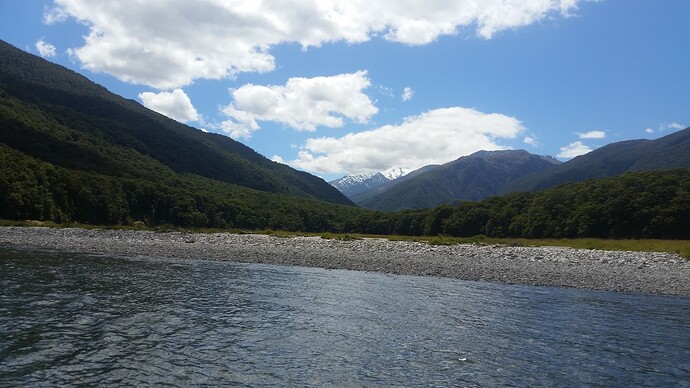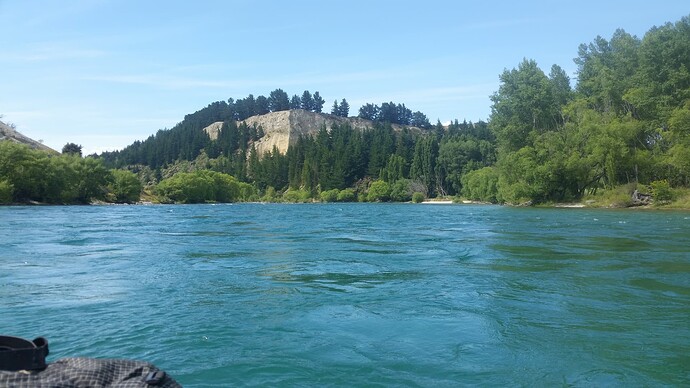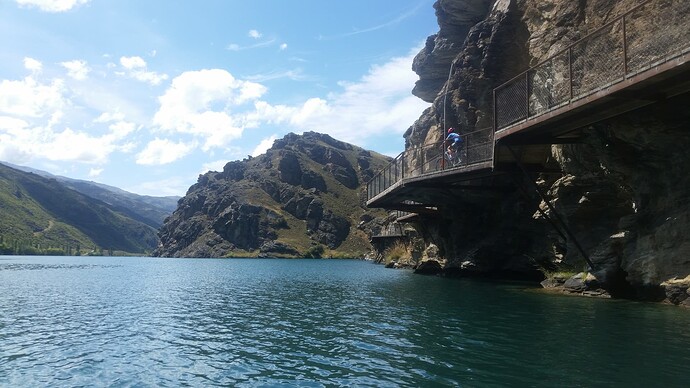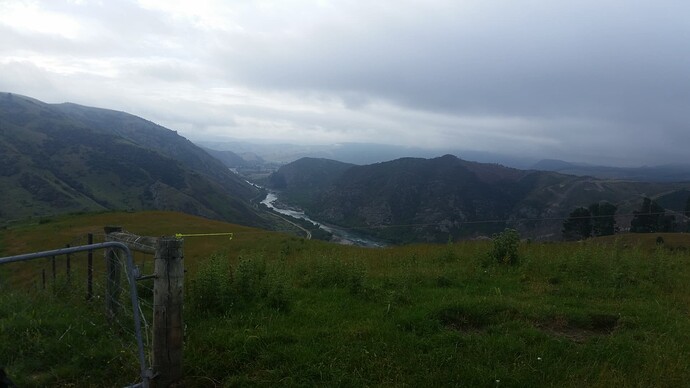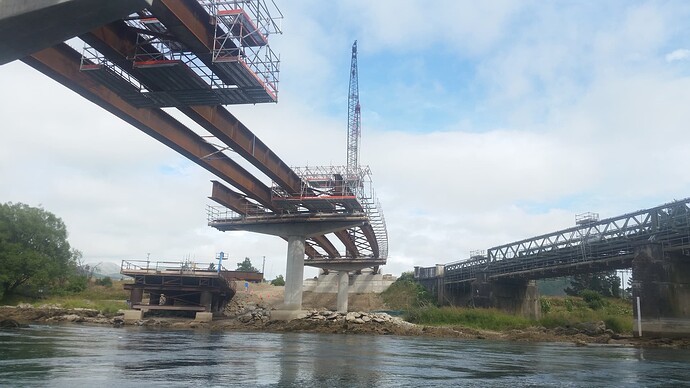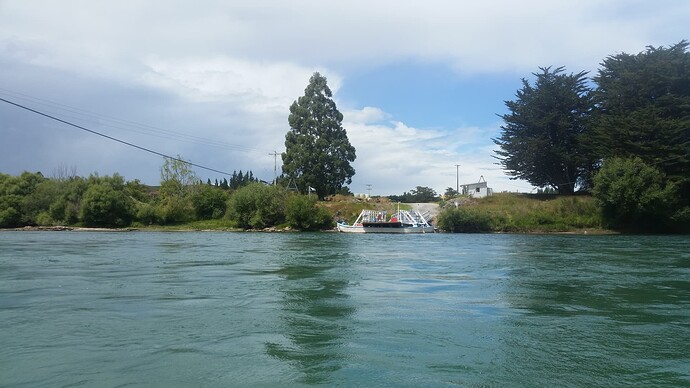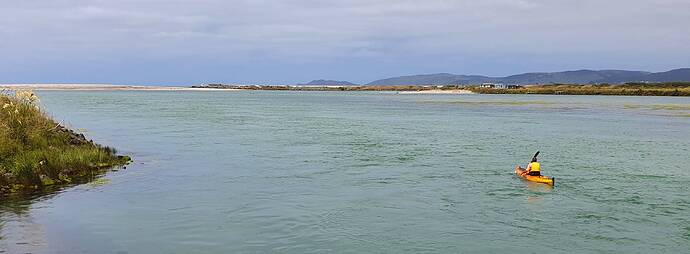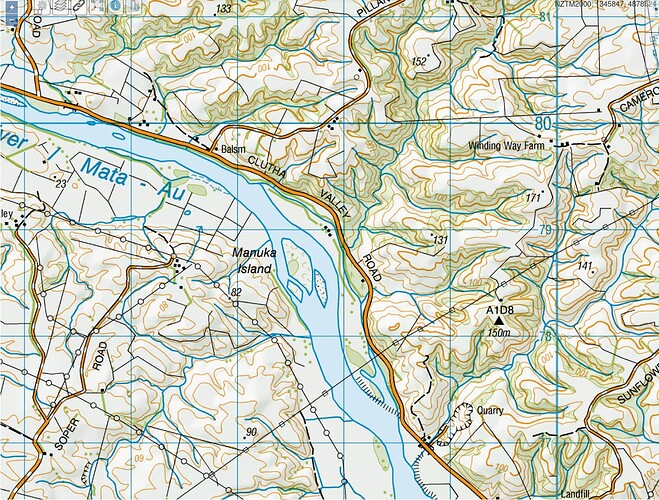This report is more about rafting / kayaking and less about radio - so sorry for that. But you can also file it under ‘the length some people will go to for a 1-point summit’!
I set myself the challenge to raft/kakak the length of the Clutha River this break, activating the interesting parks / lakes / islands / summits on the way. Given I’m the one doing the rafting/kakaing, I get to choose which source of the river to count, and as such started at the road-accessible Haast Pass.
Day 1:
A 3km tramp down the old pack-horse track took me to the put-in point where the Makarora River exits it’s gorge and runs south towards Lake Wanaka. After a long dry spell there was very little water to be had, but just enough to float the raft so long as I kept my arse in the air for the gravel-bars!
A series of class 1 and 2 rapids make for an easy but entertaining 9km through the Mt Aspiring National Park - the best being a 1km class-2 section ending at the Blue Pools swingbridge were over 100 tourists watched me paddle by. Not the place to stuff up! Having already activated the POTA/WWFF park a number of times, I skipped this activation.
Mt Aspiring National Park from Makarora River
Below the pools the river is deeper but less entertaining, and the remaining 17km to the head of Lake Wanaka was an easy paddle, the only challenge being avoiding the commercial jetboats as we both needed the same single viable line for each rapid in the low river.
==
Day 2 saw me switch to the kayak for the 54km paddle down Lake Wanaka. You’ll gather at this point that I have a support crew!
Pre-dawn Lake Wanaka
A 5:30 start saw me out on a near-mirror lake in the first chill lights of morning. After 10km of solid paddling, the Haast Highway cuts out of the valley and we’re all alone on the water - just the swish of the paddles and the distant roar of waterfalls on the valleyside. Around 6:30am as the sun rises; the lake comes up with a strong north-west swell - almost whitecapping. Then, as the sunlight creeps down the valleysides and hits the water it calms, and we’re back to towing a tidy V down the flat water.
After an early lunch at the DOC Wanaka Faces Hut, I leave the lakeshore and cut out into the Lake to the first island of the trip Mou Waho. Mou Waho’s fame comes from the Arethusa Pool on its summit. Almost at the summit of the small island, and some 200m above the lake level, this spring-fed pool sources it’s water from the mountains surrounding the lake via aquifers. It is named after a similar feature in Syracuse. It also is famous amongst ZL activators for featuring a Lake on a SOTA summit in a park on an island within a lake. How many points across how many schemes is that all worth?!
The peace of the morning is broken upon arrival. Some dozen boats are moored on the small beach at the picnic area / campground, with 5 or 6 more waiting offshore for a spot. Thankfully the kayak slips nicely in between and is soon dragged up on the beach and radio gear unloaded.
A good track leads 1km to the Arethusa Pool lookout - people are walking up in jandals and barefoot. The lookout is just within the activation zone of Mt Tyrwitt - ZL3/OT-493, but I choose to bushbash a further 200m to the actual summit, mainly to get away from the crowds.
Arethusa Pool, Lake Wanaka Below, from near ZL3/OT493
FT8 spotting via SOTAmat works, but I follow it up with a conventional post, as SOTAmat does support the ZL islands, lakes and parks schemes. An easy 8 contacts follow on 20m and 40m, including 2 park-to-parks and 1 lake-to-lake before the well runs dry.
50km paddled so far, and one point to show for it!
==
Having read on the DOC webpage that Mou Tapu also features a campground, toilet and BBQ area, I leave to shaded grassy campsite of Mou Waho and paddle on across open lake for another 6km to Mou Tapu. There’s no sign of a good landing spot on the north shore, so I paddle clockwise 3/4 round the 2km x 500m island before getting suspiscious and managing to get the Wanaka Islands webpage up on my phone. Turns out that I’d skipped a line and the campsite is on Stevensons Island some 10km east on another arm of the lake. Luckily though, camping is not prohibited on Mou Tapu, so I find a shaded spot behind the shingle beach at the western tip of the island and set up camp.
The southern face of the island, though mature podocarp bush, is a maze of cliffs and gullies, and not straightforward access. The western end where I camp is scrubby and impassable. But the northern and eastern faces are low manuka bush with some open grassy leads, and the bluffs though present are smaller and dispersed. Bands of fern tangled with hook-thorned bush-lawyer don’t look too appealing, and it’s well into the 30’s. But it’s not even 5pm and 40+ in the tent, so I give myself a good kick, pack the radio gear, and start the crawl / scramble to the summit. The 500m ‘walk’ takes 45 minutes and leaves me wishing I’d brought hiking boots, gaiters and climbing axe!
There are 2 summits on the island - both in the activation zone and separated by a 15m saddle. The higher is the western, but that turns out to be a near-impenetrable mess of fern, scrub and bush-lawyer. So I settle for the eastern summit and bag my second peak (and 2nd island, an 2nd park) of the trip.
Mou Waho & Tyrwhitt Peak (ZL3/OT-493) from Mou Tapu (ZL3/OT-487)
VKs and beyond are spotted on 15m and 10m, but as usual I hear nothing. So I settle for 7 contacts, on a mix of 20m and 40m. I get briefly excited by 9V1RT (“where is 9V1?”) before hearing the VK2/ prefix. Still, a summit-to-summit and well worthwhile.
Activating Mou Tapu
The lake is swimming-pool warm, and a beautiful evening swim washes the bush-bash remnants from my skin, hair, ears. As the sun sets the lake cools the air and I sleep the sleep of the truly exhausted. 45km and two summits. Enough for the day!
==
Day 3:
Sunday dawns early. Not that I’d have noticed, but I forgot to cancel the 4:45am alarm of the previous day, and so - like the melodious island dawn-chorus, was awake to greet it.
Leaving Mou Tapu
A 10km paddle east past the tip of the Stevenson’s peninsula took me to Bull Island (ZLI/OT-003), just 1km north offshore of the Wanaka suburbs. Approaching the island, I was getting more and more concerned. The island looked so small that I was probably going to be limited to 20m, and at 8am (ZL) and 5am or earlier in VK 20m was not going to be much use. However, thankfully the island proved longer than wide, and I found a nice beach to pull into and set up the SOTApole on the summit with full 40m-half-wave over it. The next worry was the time - 8am on New Year’s day. How many hard-living hard-playing hams were going to be awake to answer my calls? Thankfully, the answer turned out to be ‘3’ - enough for the lake and the island.
===
Lake Wanaka Outlet
Taking the touring kayak 6km down the fast-flowing Clutha to my rendez-vous at Alberttown was interesting. I bought the kayak for lake and sea travel, and have not used it on anything but flat water before. All I can say is that I know how the skippers of oil tankers in the Suez Canal must feel! You need a lot of river and some decent velocity relative to water to get the rudder to turn the thing, and swinging 5m of keeled kayak by paddles alone is not easy. Thankfully the packraft (and breakfast) are waiting for me at the Alberttown bridge, into which I arrive without incident.
==
I’ve been warned of some interesting rapids and boils below Alberttown, and so am back in the packraft for my first radio+whitewater travel. The FT818 is in a dry bag, in a waterproof packliner, in a tramping pack, lashed to the deck. And I hope all those layers of waterprooofing hold!
Clutha River - back in the packraft
The Clutha is like nothing I’ve paddled before. Not steep, not with many traditional ‘rapids’ but a huge amount of water eager to be somewhere else. Disturbed, peturbed by boulders and bars often a meter or more below the surface. A seemingly random mix of churning white water and green-blue boils and eddies.
The packraft is nimble and stable as ever, and does me proud. The one interesting moment comes at a sharp 120 degree left-turn in the river. A narrow chute of white-water surrounded by whirlpools and boils either side forming the wings of a figure-of-8. I go in too cautiously and get hooked by the left-hand whirlpool, then ejected - to a drenching - back into the whitewater chute back upriver, paddling-hard to get back into it’s centre to avoid repeating the circuit.
I have a long-standing goal (well, last year’s goal, not yet achieved - so becoming more long-standing as the years pass) to activate all of Central Otago. That includes 20 lakes, 99 parks and 71 summits. 3 of those parks are only accessible by boat and lie of the Clutha River - another reason for this trip.
With all the bends, the river descent takes longer than hoped and it’s 2pm by the time I reach the first park at the confluence of the Clutha and Lindis rivers. 1 hour after New Year rollover - and not a good time to try and activate anything. I manage the requisite 2 contacts, and hear that 17 ZL operators were out activating SOTA around rollover - a very impressive total for such a small community. Plus a few lake activations by the more ascent-averse. Sadly they’re all on the way back down their respective hills or highways by now, and I’m lucky to scrape the 2x40m contacts that I do.
Activating Lower Lindis Conservation Area (ZLP/OT-0390)
The next park takes even longer, but thankfully by 4:30pm the activators are beginning to arrive back at their shacks, and the final activation of the day at Clutha River Islands Conservation Area (ZLP/OT-0318) nets a more respectable 6. As the Clutha hits the head of Lake Dunstan, it forms a delta splitting into a maze of small and large channels and a patchwork of islands. Once a productive wetland, this area is becoming choked with exotic (i.e. not native) willows, but areas of mudflats and shallows persist with their population of ducks, waders and kingfisher-like birds that looked designed for swoop & grab type fishing (you can tell I’m not an ornithologist!).
An ever-worsening right wrist slows me down for the final 2-3km down Lake Dunstan to the Bendigo campground, where my 1-woman support crew awaits with the caravan and the promise of something cold fizzy and calorie rich.
74km for the day, and I’m good for nothing but nurofen & sleep!
==
Day 4: CANCELLED
Sadly the wrist ache of yesterday has swollen up to render it unwise to continue the adventure today. So I’ll spend my time at the table with a pack of frozen peas writing up the trip so far. The next couple of days consist of kayaking Lake Dunstan (ZLL/0279) and Lake Roxburgh (ZLL/0696), with a brief 10km river section in between.
The day after that brings more fun in class 1-2 rapids and the final summit of the trip (ZL3/OT-521), the lowest summit in Central Otago and with the shortest legal access being up the unformed legal road from the riverbank. Below Beaumont we leave Central Otago, but will pass a couple more islands (ZLI/OT-018, ZLI/OT-001) in the fast-flowing blue water before the river slows, darkens to black for the final placid (read: lots of paddling) 2 days to the coast at Balclutha,
Will I make it this break? Maybe - if the wrist comes good and the weather holds. But with both of those looking unlikely, this may turn into another long-term goal on the long list - ‘finish off that Clutha river trip’!
PS Rapids? What rapids? - The reason there are only photos of flat, calm, water is that I was too busy paddling for the more interesting bits to fish the phone out of its dry bag & take photos!
===
Logs:
ZL3/OT-493 - Tyrwhitt Peak / Mou Waho / Arethusa Pool
ZL3/OT-487 - Mou Tapu
ZLI/OT-003 Bull Island / ZLL/0830 Lake Wanaka
ZLP/OT-0390 Lower Lindis Conservation Area
ZLP/OT-0325 Clutha River / South Lindis Conservation Area
ZLP/OT-0318 Clutha River Islands Conservation Area

